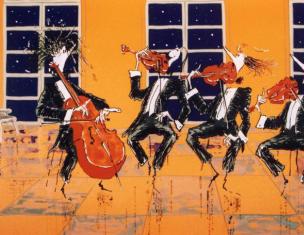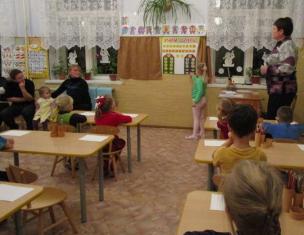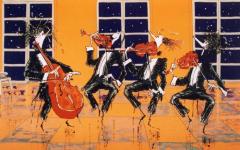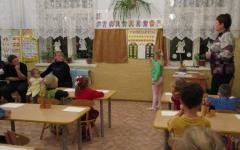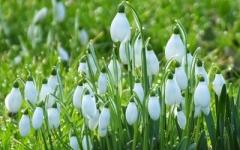slide 1

slide 2
Baroque (Italian barocco, literally - bizarre, strange), one of the dominant styles in the architecture and art of Europe and Latin America in the late 16th - mid-18th centuries. Baroque was associated with the nobility and church culture of the heyday of absolutism. It was called upon to glorify the power of the church and the secular aristocracy, gravitated towards ceremonial solemnity and pomp.
Baroque became widespread in Flanders (famous representatives of the Baroque in Flanders - P.P. Rubens, F. Snyders, J. Jordaens, A. van Dyck), in Spain, Portugal, in southern Germany, in Austria, the Czech Republic, Slovakia, Croatia, in the west of Ukraine, in Lithuania. In France, baroque merged with classicism into a single opulent style.

slide 3
Coronation of the Virgin Mary, 1595-1598
At the origins of the tradition of Baroque art in painting are two great Italian artists - Caravaggio and Annibale Carracci, who created the most significant works in the last decade of the 16th century - the first decade of the 17th century. Italian painting of the late 16th century is characterized by unnaturalness and stylistic uncertainty. Caravaggio and Carracci, with their art, restored her integrity and expressiveness.

slide 4
One of the dominant styles in European architecture and art of the late 16th and mid-18th centuries, the Baroque was established in an era of intensive formation of nations and nation-states (mainly absolute monarchies). Baroque embodied new ideas about the unity, infinity and diversity of the world, about its dramatic complexity and eternal variability, interest in the real environment, in the natural elements surrounding a person, the baroque replaced the humanistic artistic culture

slide 5
Caravaggio Michelangelo (1573-1610), Italian painter. Studied in Milan (1584-1588); worked in Rome (until 1606), Naples (1607 and 1609-1610), on the islands of Malta and Sicily (1608-1609). Caravaggio, who did not belong to a particular art school, already in his early works contrasted the individual expressiveness of the model, simple everyday motives (“Little Sick Bacchus”, “Young Man with a Basket of Fruit” - both in the Borghese Gallery, Rome) to the idealization of images and the allegorical interpretation of the plot, characteristic of the art of mannerism and academism.

slide 6
Reni Guido (November 4, 1575, Bologna - August 18, 1642, ibid.), Italian painter, master of the Baroque. Reni was a graduate of the Bologna Academy of Arts, a guide and heir to its pictorial tradition and pedagogical system. He directly studied with Annibale Carracci, was, like him, a fan of antiquity and Raphael.

Slide 7
Baroque embodied new ideas about the unity, infinity and diversity of the world, about its dramatic complexity and eternal variability; his aesthetics was built on the collision of man and the world, ideal and sensual principles, reason and irrationalism.

Slide 8
Baroque art is characterized by grandiosity, pomp and dynamics, pathetic elation, intensity of feelings, addiction to spectacular entertainment, the combination of illusory and real, strong contrasts of scales and rhythms, materials and textures, light and shadow.

Slide 9
Baroque art is characterized by: an abundance of external effects and elements. The figures of the drawing and their groups are depicted solemnly, facial expressions are sensual. In the 17th century, painting occupied an exceptional place in art. The Baroque era expanded the range of depicted objects, enriched this area of art with new genres. The artists loved warm tones and delicate color transitions, they were attracted by the play of light and shadow, the contrasts of light and dark, and paid great attention to the materialistic image.

Slide 10
Most character traits Baroque - catchy flamboyance and dynamism - corresponded to the self-confidence and aplomb of the newly regained strength of the Roman Catholic Church. Outside of Italy, the Baroque style had its deepest roots in Catholic countries, and in Britain, for example, its influence was negligible.

slide 11
Baroque art developed and flourished in Italy, where the largest architect and sculptor L. Bernini, the painter, the head of democratic realism Caravaggio, the followers of academicism, the Carracci brothers, and others worked.
"Susanna and the Elders" 1647

slide 12
The visual arts of this period were dominated by plots based on a dramatic conflict - religious, mythological or allegorical in nature.

slide 13
A person in baroque art appears as a multifaceted personality, with a complex inner world, involved in the cycle and conflicts of the environment.

Slide 14
Ceremonial portraits are created to decorate interiors.

slide 15
"The Blinding of Samson" 1636

slide 16
"Night watch" 1642 Rijksmuseum, Amsterdam

Slide 17
"Danae" 1636 Hermitage, St. Petersburg

Slide 19
"The Triumph of Belshazzar" 1635

slide 21
Maria Magdalena ca. 1600

slide 22
St. Jerome and the Angel 1635

slide 23
The Abduction of Europe 1630-1640

slide 24
Baroque architecture

Slide 25
Carlo Maderna Church of Saint Susanna, Rome
Baroque architecture (L. Bernini, F. Borromini in Italy, B. F. Rastrelli in Russia) is characterized by spatial scope, unity, fluidity of complex, usually curvilinear forms. There are often deployed large-scale colonnades, an abundance of sculptures on facades and in interiors, volutes, big number rake-outs, arched facades with a rake-out in the middle, rusticated columns and pilasters. Domes acquire complex shapes, often they are multi-tiered, like at St. Peter's Cathedral in Rome. Characteristic details of the Baroque - telamon (atlas), caryatid, mascaron.
The quintessence of the Baroque, an impressive fusion of painting, sculpture and architecture, is the Coranaro Chapel in the church of Santa Maria della Vittoria (1645-1652).

slide 26
In Russia, the development of baroque art, which reflected the growth and strengthening of the absolute monarchy of the nobility, falls on the first half of the 18th century. The Baroque style in Russia was free from exaltation and mysticism (characteristic of the art of Catholic countries) and had a number of national features. Russian baroque architecture, which reached majestic proportions in the city and manor ensembles of St. . Rastrelli, D. V. Ukhtomsky); fine Arts turned to secular, social themes, the portrait was developed (sculptures by B. K. Rastrelli and others). The Baroque era was marked everywhere by the rise of monumental art and arts and crafts, closely interconnected with architecture. In the 1st floor. 18th century baroque evolves to the graceful lightness of the rococo style, coexists and intertwines with it, and from the 1770s. everywhere superseded by classicism.

Slide 27
The city ensemble, the street, the square, the park, the manor - began to be understood as an organized artistic whole, developing in space, unfolding in a variety of ways before the viewer. Baroque palaces and churches, thanks to the luxurious, bizarre plasticity of facades, the restless play of light and shade, complex curvilinear plans and outlines, acquired picturesqueness and dynamism and, as it were, poured into the surrounding space. The ceremonial interiors of Baroque buildings were decorated with multicolored sculpture, molding, and carving; mirrors and murals illusoryly expanded the space, and ceiling paintings created the illusion of yawning vaults.
Architect: Vist A. F. Built: 1764-1768 Style: Baroque
Cathedral of St. Andrew the First-Called

Slide 28
Architect: Quarenghi D. Built: 1761-1769, 1783 Style: Baroque
Cathedral of the Vladimir Icon of the Mother of God with a bell tower

Slide 29
Architects: Chevakinsky S. I. Year of construction: 1753-1755 Style: Baroque
Palace of I. I. Shuvalov

slide 30
Cathedral of St. Equal-to-the-Apostles Prince Vladimir - Prince Vladimir Cathedral
Architects: Zemtsov M. G. Rinaldi A. Starov I. E. Year built: 1789 Style: Baroque

Slide 31
Architects: Trezzini G. Built: 1730-1740 Style: Baroque
The building of the First Cadet Corps

slide 32
Summer Palace of Peter I in the Summer Garden
Lattice of the Summer Garden. Arch. Yuri Matveyevich Felten (1770-1784).
Presentation for the lesson Prepared by the teacher of the MHK and OPK MBOU "Stepurinskaya secondary school" Inzhevatova Svetlana Borisovna
Topic: “Baroque. New worldview in the Baroque era
Repetition. Introduction to the topic of the lesson. Work with the table Task: Analyze and harmonize the art styles of European culture
|
art style |
Peculiarities |
|
rebirth |
|
|
art style |
Peculiarities |
|
The Proto-Renaissance is the time when the old age-old foundations were broken and new social and artistic ideas were born, where the traditional religious background and connection with the late Gothic were fully preserved. |
|
|
rebirth |
The Renaissance is a special complex of culture based on the combination of the ideal ancient form with the purity of the Christian soul, bodily beauty with spirituality. |
|
Post-Renaissance - reflected ideas about the complexity and diversity of the world, which corresponded to the new picture of the universe - changeable and conflicting, where obsolete and born are in constant confrontation, and a person with his passions, confusing, complex inner world often finds himself at the mercy of irrational forces |
Theme of the lesson: "A new worldview in the Baroque era and its reflection in art"
Lesson Objectives:
- identification of the features of the main areas of art of the Baroque era; the formation of skills for evaluating works of art, analysis and generalization, independent construction of conclusions
- the formation of skills and needs to independently replenish their knowledge, skills, skills through the method of projects
- Identify the features of the main areas of art of the Baroque era.
- Systematize knowledge on the topic, supplementing them with new information;
- To form the skills of evaluating works of art, analysis and generalization, independent construction of conclusions;
- To promote the development of creative skills;
- Stimulate the development of self-education abilities.
- Launch an individual project
- Lorenzo Bernini Cathedral of St. Peter
- Filippo Brunelleschi Cathedral of Santa Maria del Fiore
Catherine Palace
TSARSKOE Selo
Church of Santissimo Annunziata.
Compare styles. Baroque Revival
Rubens Peter Paul
Mars and Rhea Sylvia
Raphael Santi "The Holy Family under the Oak" Answer the questions
- explain the term "Baroque"
- explain when and why it happened
- What is the peculiarity of the style?
- Baroque(From Italian barocco - whimsical, strange) - one of the great styles. He dominated the architecture and art of European countries at the end of the 16th - the middle of the 18th centuries. The birthplace of the Baroque is Italy, where the adoption of a new style meant the end of the Renaissance with its harmonious worldview, faith in the limitless possibilities of the human mind and the orderliness of universal existence.
- The main characteristics of the Baroque scale, an abundance of decor, stormy dynamics, the desire for illusory effects in the organization of interior space - an increase in the size of rooms with the help of mirrors; the height of the halls thanks to the picturesque plafonds, which have a complex solution of perspective.
- All this corresponded to the new picture of the universe - changeable, conflict, where obsolete and born are in constant confrontation, and a person with his passions, tangled, complex inner world often finds himself at the mercy of irrational forces.
... But before the beauty of both the building and the facade
The fountain, and the marble, and the fence have faded.
... In the twisted ornament you will see here and there
Victorious helmet and vases of incense,
Columns, capitals, pilasters and arcades
You will see everywhere you do not throw your eyes,
Cupids, monograms woven secretly,
And the heads of lambs entwined with lace,
And you will find a statue in a magnificent niche,
In patterns and carvings, a cornice under the very roof
CHARACTER TRAITS
- grandiosity
- Splendor and dynamics
- Intensity of feelings
- Passion for spectacular spectacles
- The abundance of decor
- The combination of the illusory and the real,
- Strong contrasts of scales and rhythms of materials and textures, light and shadow.
4. Architecture and sculpture
3. Science and literature
2. Music and theater
Project topics:
- Baroque architecture and sculpture.
- Baroque painting.
- Science and literature of the Baroque era
- Music and theater of the Baroque era.
- Russian baroque
- What did you learn in class today?
- What have you learned?
- What did you like about the lesson?
- What happened?
- What were the problems?
- - Did the baroque retain the features of the Renaissance?
- - Is there anything really new?
Internet resources:
1. www.rusedu.ru
2. mou41.togliatty.rosshkola.ru
3.imc.rkc-74.ru
4. www.rusedu.ru
5. www.openclass.ru
6. www.arhitekto.ru
8. dictionary.yandex.ru
10. www.citywalls.ru
11. en.wikipedia.org
12.arx.novosibdom.ru
13. zodchestwo.info
14. www.facade-project.ru
15. viimiracula.ru
"Baroque in Italy"– a presentation on the MHK, which will introduce the work of outstanding Italian painters, sculptors, architects and their wonderful creations.

Baroque in Italy
What does "baroque" mean? How does this style differ from Renaissance art? Look at these Davids: Donatello, Michelangelo and Bernini, and everything will become clear to you!

Three Davids
When compared, a special expression, dynamics, characteristic of David Lorenzo Bernini, immediately catches the eye. It is movement that is the most striking distinguishing feature of Baroque art.
Another way to dive into the topic - slideshow "Baroque":
After viewing, you can suggest compiling cinquain or pick up as many epithets as possible that characterize what they saw.
"Weird, quirky"
This is how the word "baroque" is translated from Italian. The 17th century gave European art two great styles: baroque and classicism. The birth of the Baroque style is associated with a change in the worldview and attitude of a person at the end of the 16th - 17th centuries, which, in turn, is a consequence of changes in the economy and science. Confidence in the limitless abilities of a person is replaced by the understanding that a person is just a “thinking reed”, and the Universe, in which he now feels like a grain of sand, is actually limitless.
The outstanding English poet, thinker, scientist, philosopher John Donne expressed this attitude very clearly in poetic form:
All new philosophers are in doubt.
Ether rejected - no ignition,The sun is gone and the earth is gone
And how to find them - knowledge is gone.
Everyone admits that our world is running out,
If they are looking for between the planets, in the vault of heaven
New knowledge ... But it will hardly happen
Discovery - everything collapses into atoms.
Everything is made of particles, but the whole is gone,
wickedness has prevailed among men,
The ties fell apart, betrayed into oblivion
Father and son, power and obedience.
And everyone thinks "I'm the Phoenix Bird"
From all others wanting to turn away ...
Harmony, balance, characteristic of the art of the Renaissance, already in the late works of Michelangelo are replaced by expression, dynamism, the desire for scale.

Baroque
Lorenzo Bernini - the genius of the Baroque
The Baroque style was most widespread in countries under the rule of the Catholic Church. It was she who was the main customer of baroque artists. Italy is the origin of this style. In my presentation "Baroque in Italy" I present the most important Italian artists and their creations. Perhaps the most prominent among them was Lorenzo Bernini, who can be called the main architect of Rome. His work is characterized by the desire to create ensembles. In them, he combines architecture, sculpture with space, using as means of expression air, light, water.
Fountains of Bernini

Fountains of Rome
“The fountain, a peculiar and long-standing genre of monumental and decorative sculpture, attracted Bernini’s attention both because of the purely Roman tradition, which assigned a large place to water sources in the life of the city, and for deeper creative motives. In this genre, the connection between sculptural and architectural principles is especially close. A third principle joins the synthesis of these two principles: Live nature, directly involved in the artistic composition of the fountain in the form of streams, jets, splashes, ups and downs of water. Bernini worked on fountains as a serious and deep artistic theme.
- Encyclopedia for Children, Volume 7, Art. - M .: "Avanta +",
- Small children's encyclopedia "Art". - M .: Russian Encyclopedic Partnership, 2001.
- Encyclopedia of knowledge "Art". - M .: LLC Publishing house "Astrel", 2001.
- Borev Yu.B. Aesthetics. - M.: Politizdat, 1988.
- Argan J.K. History of Italian Art. Moscow, OAO Raduga Publishing House. 2000.
- Arkin D.E. Images of architecture and images of sculpture. - Moscow "Art", 1990.
- Emokhonova L.G. World Artistic Culture: Proc. Allowance for students. avg. ped. textbook Institutions. - M .: Publishing Center "Academy", 1998.
- Lvova E.P., Kabkova E.P., Nekrasova L.M., Stukalova O.V., Olesina E.P. World Art. Age of Enlightenment. - St. Petersburg: Peter, 2006.
- Muratov P.P. Images of Italy. - Moscow, Republic Publishing House, 1994.
- Petrukhintsev N.N. XX lectures on the history of world culture: Proc. Allowance for students of higher education textbook Institutions. – M.: Humanit. Ed. Center VLADOS, 2001.
Good luck!
![]()
2 slide
Baroque - art (Baroque art.), the style of European art and architecture of the XVII-XVIII centuries. AT different time different meanings were put into the term "baroque". At first, it had an offensive connotation, implying absurdity, absurdity (perhaps it goes back to the Portuguese word for an ugly pearl). At present, it is used in art criticism to determine the style that dominated European art between Mannerism and Rococo, that is, from about 1600 to the beginning of the 18th century. From the mannerism of the Baroque, art inherited dynamism and deep emotionality, and from the Renaissance - solidity and splendor: the features of both styles harmoniously merged into one single whole.

3 slide
The Baroque style was born as a result of the emergence of a new type of temple, which, in turn, arose as a reaction to Protestantism. Baroque spiritualizes all parts of the building and interior, replacing straight lines with curved ones, subordinating inanimate nature to the rhythm of movement and breathing, populating planes and corners with stucco images of animals and people. The Roman Church of San Carlo alle Quattro Fontane (at the four fountains), created by F. Borromini.

4 slide
AT social relations baroque can be seen as a continuation of the royal chambers - the architecture of buildings, gardens and parks is a continuation of the interior. Carpets and mosaics of flower beds, trimmed "corrected" vegetation of French parks with statues, arbors and pavilions, ponds, buildings decorated on the outside with modeling and painting blurred the differences between the boudoir, the park and the opera scenery.

5 slide
Baroque man. Baroque man rejects naturalness, which is identified with savagery, arrogance, tyranny, brutality and ignorance - all that in the era of romanticism will become a virtue. The Baroque woman cherishes the pallor of her skin, she wears an unnatural, frilly hairstyle, a corset and an artificially extended skirt on a whalebone frame. She is in heels. Portrait of Madame de Montespan, mistress of Louis XIV.

6 slide
And the gentleman becomes the ideal of a man in the Baroque era - from the English. gentle: “soft”, “gentle”, “calm”. Initially, he preferred to shave his mustache and beard, wear perfume and wear powdered wigs. Why force, if now they kill by pulling the trigger of a musket. In the Baroque era, naturalness is synonymous with brutality, savagery, vulgarity and extravagance. Anthony van Dyck. Portrait of James Stuart, c. 1637

7 slide
Baroque is characterized by the idea of ennobling nature on the basis of reason. Need not to endure, but “it is good to offer in pleasant and courteous words” (Youth, an honest mirror, 1717). According to the philosopher Spinoza, instincts no longer constitute the content of sin, but "the very essence of man." Therefore, the appetite is formalized in exquisite table etiquette (it was in the Baroque era that forks and napkins appeared); interest in the opposite sex - in a courteous flirtation, quarrels - in a sophisticated duel.

8 slide
Baroque is characterized by the idea of a sleeping God - deism. God is conceived not as a Savior, but as a Great Architect who created the world just as a watchmaker creates a mechanism. Hence such a characteristic of the Baroque worldview as mechanism. The law of conservation of energy, the absoluteness of space and time are guaranteed by the word of God. However, having created the world, God rested from his labors and does not interfere in the affairs of the Universe in any way. It is useless to pray to such a God - one can only learn from Him. Therefore, the true guardians of the Enlightenment are not prophets and priests, but natural scientists. Isaac Newton discovers the law of universal gravitation and writes the fundamental work The Mathematical Principles of Natural Philosophy (1689), and Carl Linnaeus systematizes biology in The System of Nature (1735). Academies of Sciences and scientific societies are being established everywhere in European capitals.

9 slide
The diversity of perception raises the level of consciousness - something like the philosopher Leibniz says. Galileo for the first time directs a telescope to the stars and proves the rotation of the Earth around the Sun (1611), and Leeuwenhoek discovers tiny living organisms under a microscope (1675). Huge sailboats plow the expanses of the world's oceans, erasing white spots on geographical maps peace. The literary symbols of the era are travelers and adventurers: Captain Gulliver and Baron Munchausen.

10 slide
The Baroque era gives rise to a huge amount of time for entertainment: instead of pilgrimages - the promenade (walks in the park); instead of jousting tournaments - "carousels" (horseback rides) and card games; instead of mysteries - theater and masquerade balls. You can add the appearance of swings and "fiery fun" (fireworks). In the interiors, portraits and landscapes took the place of icons, and music turned from spiritual into a pleasant play of sound.

11 slide
Baroque in painting. The Baroque style in painting is characterized by the dynamism of compositions, the “flatness” and pomp of forms, the aristocracy and originality of subjects. The most characteristic features of the Baroque are catchy flamboyance and dynamism; a striking example is the work of Rubens and Caravaggio. Caravaggio. The call of the apostle Matthew.

12 slide
Painting should show the living, moving essence of things, first of all, with the help of light, which was traditionally seen as an outpouring of the deity. If previously sacred history was perceived as having happened long ago, then baroque art revealed to us a new plane of reality, in which the miraculous happens all the time. It can also be seen in everyday everyday scenes (if they are illuminated with this divine light).

13 slide
The most striking painter of this style was P. P. Rubens, who filled his giant canvases with arrays of muscular bodies, bathed in the golden sparkling light of sunset. Peter Paul Rubens. Self-portrait among friends Mantua

14 slide
Peter Paul Rubens. Union of Earth and Water, 1618 Peter Paul Rubens. Three Crucifixes, 1620

15 slide
Peter Paul Rubens. Heracles, 1611 Peter Paul Rubens. Nailed Prometheus, 1610-1611

16 slide
Less festive, but more profound are the paintings of Rembrandt - the peaks of the 17th century. Sparingly spending the bright rays of the sun, the painter only for a moment makes the tragic reality recede into darkness, which often occupies most of the canvas. Rembrandt Harmenszoon van Rijn. The Return of the Prodigal Son, 1669

17 slide

18 slide

19 slide

20 slide
Baroque in architecture. Baroque architecture (L. Bernini, F. Borromini in Italy, B. F. Rastrelli in Russia, Jan Christoph Glaubitz in the Commonwealth) is characterized by spatial scope, unity, fluidity of complex, usually curvilinear forms. Large scale colonnades, an abundance of sculpture on facades and in interiors, volutes, a large number of rake-outs, arched facades with a rake-out in the middle, rusticated columns and pilasters are often found. The domes acquire complex forms, often they are multi-tiered, as in St. Peter's Cathedral in Rome. Characteristic details of the Baroque - telamon (atlas), caryatid, mascaron.

21 slide
The most grandiose ensemble in the Baroque style are the Cathedral and St. Peter's Square in Rome.

22 slide
San Marco is a three-nave titular basilica in Rome, on Piazza San Marco, surrounded by the Palazzo Venezia. The church was built in 336. In 1740-1750, the interior of the church was restored in the Baroque style.

23 slide

24 slide

25 slide
Il Gesu Church was built in 1568-1584. in the spirit of Mannerism, which quite closely foreshadowed the aesthetics of the Baroque (architects Giacomo da Vignola and Giacomo della Porta, the initial project was prepared by Michelangelo).

26 slide

27 slide
Baroque in Literature. Writers and poets in the Baroque era perceived the real world as an illusion and a dream. Realistic descriptions were often combined with their allegorical depiction. Symbols, metaphors, theatrical techniques, graphic images (lines of poetry form a picture), saturation with rhetorical figures, antitheses, parallelisms, gradations, oxymorons are widely used. There is a burlesque-satirical attitude to reality. Baroque literature is characterized by the desire for diversity, for the summation of knowledge about the world, inclusiveness, encyclopedism, which sometimes turns into chaos and collecting curiosities, the desire to study being in its contrasts (spirit and flesh, darkness and light, time and eternity).

28 slide
Baroque ethics is marked by a craving for the symbolism of the night, the theme of frailty and impermanence, life-dream (F. de Quevedo, P. Calderon). Calderon's play "Life is a dream" is well-known. Such genres as the gallant-heroic novel (J. de Scudery, M. de Scudery), the real-life and satirical novel (Furetière, C. Sorel, P. Scarron) are also developing. Within the framework of the Baroque style, its varieties are born, directions: marinism, gongorism (culteranism), conceptism (Italy, Spain), metaphysical school and euphuism (England) The actions of the novels are often transferred to the fictional world of antiquity, to Greece, court gentlemen and ladies are depicted shepherds and shepherdesses, which was called the pastoral (Honoré d'Urfe, "Astrea"). Poetry flourishes pretentiousness, the use of complex metaphors. Common forms such as sonnet, rondo, concetti (a short poem expressing some witty thought), madrigals.

slide 2
Rome is considered the birthplace of the Baroque, and the most striking examples of the architecture of this style were created in Italy, Spain, Portugal, Southern Germany, the Czech Republic, Poland, Lithuania, Spanish and Portuguese colonies in Latin America. In all these countries, the Catholic Church was very influential and thus the Baroque became the style it adopted.
slide 3
The beginning of a new style is usually considered the construction of a small church of the Jesuit order - Il Gesu in Rome, begun in 1568 according to the project of Giacomo Vignola. The birth of a new style can be seen on the main façade, which overlooks a small square, completed in 1575. Designed by Giacomodel Porta: columns and pilasters move towards each other, grouped in pairs, the entablature breaks, the surface of the façade is overloaded with strong rhythmic elements.
slide 4
The most prominent masters of the Baroque in Italy were Lorenzo Bernini, who created the grandiose ensemble of St. Peter's Square in Rome and other buildings, including numerous sculptures and fountains,
slide 5
And Francesco Borromini, according to whose designs the churches of San Carlo alle Quattro Fontane, the church of Sant Ivo alla Sapienza in Rome, etc. were built.
slide 6
In baroque architecture, the balance of masses and space, the harmony of carried and bearing parts, the calm measured rhythm, characteristic of Renaissance architecture, are violated. The masses of the building come to life, come into motion, architectural forms they begin to push each other, break the boundaries of clear geometric shapes, solid material turns into a pliable mass, decorative details create a bizarre play of light and shadow. Plans of baroque buildings receive complex outlines of conjugated ovals and other irregular shapes. Both external and internal space are included in this violent struggle. The facades of baroque buildings, whimsically curving, involve the surrounding streets and squares in their rapid movement. Baroque architecture is the architecture of large-scale urban and suburban ensembles, which gave a powerful impetus to the further development of urban planning.
Slide 7
In France, one of the most remarkable Baroque palace ensembles was created - Versailles (1668-1689), which became a model for luxurious country residences of European monarchs, including Russian ones.
Slide 8
The building of the Palace, designed by the architects Louis Leveau and Hardouin Mansart, combines classical clarity and austerity of volumes with the baroque organization of the interior space of the main Mirror Gallery, the framework of which is illusoryly expanded by mirrors and murals. The abundance of gilding, sculpture and painting in the interiors will later become a favorite technique of baroque architecture. In plafond painting, the image of the firmament with angels and clouds in perspective is conveyed so accurately that it is difficult to determine where the border of real space passes, and where the illusion of reality begins.
Slide 9
In the 18th century, baroque took root in Russia. The new manners of the royal court and the new Russian nobility, which since the time of Peter I were persistently introduced into use in Russia, demanded the European type of palaces, where luxurious balls, ceremonial receptions, and rich dinners could be held. Peter I himself gravitated more towards the Protestant restraint of Dutch architecture, but his daughter, Elizaveta Petrovna, leaned towards the forms of lush Italian baroque. During the years of her reign (1741-1761), the best examples of Russian baroque were created, which differed from Italian in worldly cheerfulness and the absence of religious mysticism, and from German or Austrian in emphasized scale and monumental scope. architectural ensembles.
Slide 10
by the most outstanding architect Russian baroque was Francesco Bartolomeo Rastrelli. Only he was able to build for Elizabeth such a palace in Tsarskoye Selo that would meet her needs and taste. The facade of the palace itself is so strongly rhythmically dissected by powerful "blows" of white columns that stand out against a blue background, that there can be no question of any monotony. Only by looking closely, you can see behind the choir of columns and pilasters the traditional three-sided construction of the palace building.
slide 11
The main hall of the palace is the Great Gallery (17 m wide, 47 m long, 7 m high, with total area 800 sq. m) without a single internal support. In addition to real windows, there are also fake ones - mirrors that artificially expand the huge interior space. Patterns of typesetting parquet, gilded wood carving, ceiling painting - everything in this room is striking in its sophistication, betraying the hand of a brilliant master. All rooms in the palace are different, there is a Chinese one, and a crimson one, and the famous
slide 12
and the famous Amber Room - a wonder of the world, presented to Peter I in 1716 by the Prussian king.
slide 13
Of the other buildings of Rastrelli, one cannot fail to mention the famous Winter Palace with a magnificent front staircase, where the architect used the same effects of fake windows - mirrors to visually expand the space, and the Smolny Cathedral in St. Petersburg. Rastrelli's style is impossible not to recognize. Even in small buildings, such as the Cathedral of the Smolny Monastery, he managed to create a bright, cheerful, high spirits, a lively play of light and color, a solemn rhythm of forms, an exquisite silhouette of a five-domed completion.
Slide 14
AT different countries Baroque manifested itself in different ways, but its characteristic features and formal signs can be found everywhere. These are complex curvilinear plans, thickened columns that replaced the flat pilasters of the Renaissance, a torn entablature, rhythmic diversity and saturation, powerful plasticity of the walls, violent movement, the struggle of masses and space, involving external space in it, the creation of a synthesis of arts, united by a common idea and style, the creation of majestic architectural ensembles in cities and palace and park ensembles in country residences, an abundance of gold, wood and stone carvings, lush decorative details and sculptures, a rich play of color and light. This is a style based on the use of classical architectural order forms, brought into a state of dynamic tension, sometimes reaching convulsions.
slide 15
baroque man
Baroque man rejects naturalness, which is identified with savagery, arrogance, tyranny, brutality and ignorance - all that in the era of romanticism will become a virtue. The Baroque woman cherishes the pallor of her skin, she wears an unnatural, frilly hairstyle, a corset and an artificially extended skirt on a whalebone frame. She is in heels. And the gentleman from the English becomes the ideal of a man in the Baroque era. gentle: “soft”, “gentle”, “calm”. Initially, he preferred to shave his mustache and beard, wear perfume and wear powdered wigs. Why force, if now they kill by pulling the trigger of a musket. In the Baroque era, naturalness is synonymous with brutality, savagery, vulgarity and extravagance. For the philosopher Hobbes, the state of nature is a state characterized by anarchy and war of all against all. Madame de Montespan, baroque woman
slide 16
Baroque in painting
The Baroque style in painting is characterized by the dynamism of compositions, the “flatness” and pomp of forms, the aristocracy and originality of subjects. The most characteristic features of the Baroque are catchy flamboyance and dynamism; a striking example is the work of Rubens and Caravaggio.
- Rubens. Venus and Adonis.
- Caravaggio. Saint Jerome
View all slides



